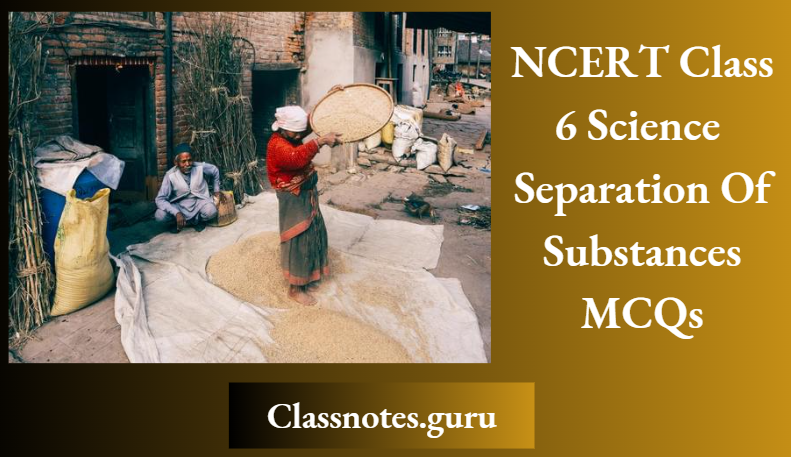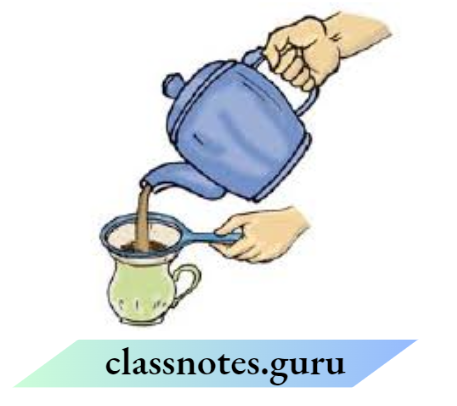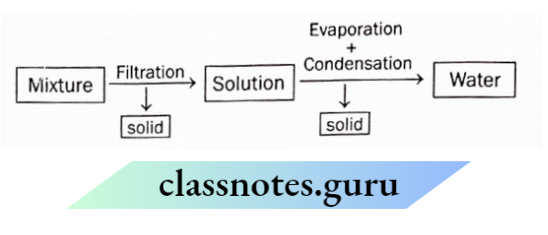Separation Of Substances Multiple Choice Questions
Question 1. Paheli bought some vegetables such as French beans, ladyfinger, green chilies, brinjals, and potatoes all mixed in a bag. Which of the following methods of separation would be most appropriate for her to separate them?
- Winnowing
- Sieving
- Threshing
- Handpicking
Answer: 4. Handpicking
Question 2. Boojho’s grandmother is suffering from diabetes. Her doctor advised her to take ‘lassi’ with less fat content. Which of the following methods would be most appropriate for Boojho to prepare it?
- Filtration
- Decantation
- Churning
- Winnowing
Answer: 3. Churning
Read and Learn More NCERT Class 6 Science MCQs
Question 3. Which of the following methods would be most appropriate to separate grains from bundles of stalks?
- Handpicking
- Winnowing
- Sieving
- Threshing
Answer: 4. Threshing
Question 4. Which method is used for separating heavier and lighter components by blowing air?
- Sieving
- Threshing
- Winnowing
- Sedimentation
Answer: 3. Winnowing
Question 5. Four mixtures are given below.
- Kidney beans and chickpeas
- Pulses and rice
- Rice flakes and corn
- Potato wafers and biscuits
Which of these can be separated by the method of winnowing?
- 1 And 2
- 2 And 3
- 1 And 3
- 3 And 4
Answer: 4. 3 And 4

Question 6. While preparing chapatis, paheli found that the flour to be used was mixed with wheat grains. Which of the following is the most suitable method to separate the grains from the flour?
- Threshing
- Sieving
- Winnowing
- Filtration
Answer: 2. Sieving
Question 7. The easiest separating method which can be used to separate wheat bran from flour is
- Handpicking
- Sieving
- Evaporation
- Filtration
Answer: 2. Sieving
Question 8. A bottle contains either salt or chalk. What process would you use to identify them?
- Sedimentation
- Evaporation
- Winnowing
- Sieving
Answer: 1. Sedimentation
Question 9. You might have observed the preparation of ghee from butter and cream at home. Which method(s) can be used to separate ghee from the residue?
- Evaporation
- Decantation
- Filtration
- Churning
Which of the following combinations is the correct answer?
- 1 And 2
- 2 And 3
- 2 And 4
- Only 4
Answer: 2. 2 And 3
Question 10. Tea leaves are separated with a strainer while pouring tea. What property of tea leaves is used to separate them from the tea?

- Size
- Mass
- Shape
- Thickness
Answer: 1. Size
Question 11. Which of the following mixtures would you be able to separate using the method of filtration?
- Oil in water
- Cornflakes in milk
- Salt in water
- Sugar in milk
Answer: 2. Cornflakes in milk
Question 12. Which of the following processes is used to remove the pulp from the juice before drinking?
- Sedimentation
- Hand-picking
- Decantation
- Filtration
Answer: 4. Filtration
Question 13. The ponds and other water bodies dry up at a faster rate during summers by the process known as
- Evaporation
- Condensation
- Decantation
- Distillation
Answer: 1. Evaporation
Question 14. In the activity, a teacher dissolved a small amount of solid copper sulfate in a tumbler half-filled with water. Which method would you use to get back solid copper sulfate from the solution?
- Decantation
- Evaporation
- Sedimentation
- Condensation
Answer: 2. Evaporation
Question 15. During summer, boojho carries water in a transparent plastic bottle to his school. One day, he left his bottle in the school. The bottle still had some water left in it. The next day, he observed some water droplets on the inner surface of the empty portion of the bottle. These droplets of water were formed due to
- Boiling and condensation
- Evaporation and saturation
- Evaporation and condensation
- Condensation and saturation
Answer: 3. Evaporation and saturation
Question 16. A student has a solution of salt, sand, and water. Which option explains the processes required to separate the salt and sand from water?
- Evaporation to remove sand, filtration to obtain salt
- Filtration to remove sand, evaporation to obtain salt
- Filtration to remove sand, sedimentation to obtain salts
- Sedimentation to remove sand, filtration to obtain salt
Answer: 2. Filtration to remove sand, evaporation to obtain salt
Question 17. Paheli asked for a glass of water from Boohoo. He gave her a glass of ice-cold water. Paheli observed some water droplets on the outer surface of the glass and asked Boojho, how these droplets of water were formed. Which of the following should be Boojho’s answer?
- Evaporation of water from the glass
- Water that seeped out from the glass
- Evaporation of atmospheric water vapor
- Condensation of atmospheric water vapor
Answer: 4. Condensation of atmospheric water vapor
Question 18. Which of the following can dissolve in water?
- Iron dust
- Oil
- Chalkdust
- Salt
Answer: 4. Salt
Question 19. A salt solution gets saturated when a student mixes 10 gms of salt in 60ml of water in a beaker. The student further added logos of salt in the solution that does not dissolve in water. The student adds 20ml of water to a beaker and observes some of the salt is dissolved. The amount of water needed to dissolve the remaining salt is?
- 5 Mb
- 10Ml
- 20 Ml.
- 40 Ml
Answer: 4. 40 Ml
Question 20. A student did the following activity to separate the constituents of a mixture as shown below

What could have been the mixture?
- Water + sand + glass
- Oxygen + water + salt
- Stones + rice + water
- Sand + sugar + water
Answer: 4. Sand + sugar + water
Question 21. A student takes some cold water in a beaker and dissolves two tablespoons of salt in it. When the student adds one more tablespoon of salt, it gets settled at the bottom of the beaker. The student warms the water and observes that the salt disappears. What can be the reason for this observation?
- Heat increases the solubility of water
- Heat evaporates the excess salt in solution
- After heating the solution becomes saturated
- Two tablespoons of salt make the solution unsaturated
Answer: 1. Heat increases the solubility of water
Question 22. Raman had kept three things, salt, and rice grains separately to do some experiments. Somehow everything got mixed up. Choose the correct option that contains a correct sequence of methods which is used to separate all these things again.
- Add water → evaporation → sieving → sedimentation
- Add water → sedimentation → sieving → evaporation
- Add water → sieving → evaporation → sedimentation
- Sieving → add water → sedimentation evaporation
Answer: 4. Sieving → add water → sedimentation evaporation
Question 21. Choose the correct statement about decantation from the following.
- The process of settling down heavier, insoluble particles in a mixture
- The process of changing a solid into a vapor state
- Separating insoluble solids from a liquid using filter paper
- The process of transferring the clear liquid without disturbing the sediments
Answer: 4. The process of transferring the clear liquid without disturbing the sediments
Question 22. The property which forms the basis of sieving is a difference of components in
- Size
- Color
- Shape
- Weight
Answer: 1. Size
Question 3. The first process after harvesting is
- Reaping
- Threshing
- Sieving
- Winnowing
Answer: 2. Threshing
Question 4. Common salt is recovered from seawater by the process of
- Filtration
- Evaporation
- Sublimation
- Decantation
Answer: 2. Evaporation
Question 5. Threshing is done by
- Wilting
- Bullocks
- Machines
- All of these
Answer: 4. All of these
